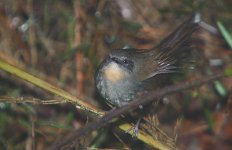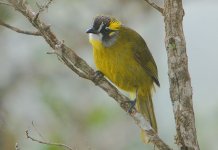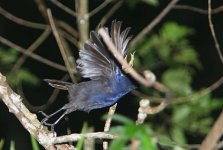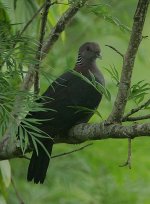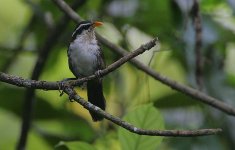Eventually, the final instalment:
PART 5: Land of the Ancient Kingdoms
On the morning of 5th August we headed back to Kandy en-route to Sigiriya and the cultural triangle. Kandy was particularly busy with a heavy security presence as the Sri Lankan president and various other dignitaries were in town for the final day of the Perahera. We made our way towards The Temple of The Tooth having to negotiate two security checkpoints in the process. After checking in our shoes at a small kiosk we entered the temple complex barefoot. The Temple of The Tooth proved to be a very impressive building housing a number of spectacular artefacts, beautiful murals and sporting many intricate ornamental carvings. The centrepiece of the temple is the spectacularly ornate “room” housing The Buddha’s tooth-relict within a casket. On the final day of the Perahera the tooth casket is carried on the back of a huge tusker through the streets of Kandy in a spectacular torch-lit procession in one of the most flamboyant religious festivals in all Asia.
Heading out of Kandy we made our way north towards the dry plains around Dambulla. Our next destination was the Amaya Lake hotel which is situated in open woodland on the shore of the large Kandalama tank. This comfortable hotel comprises of a large restaurant/reception/bar complex with an adjacent large swimming pool whilst accommodation is within air-conditioned bungalows dotted throughout the wooded grounds. Amaya Lake proved to be an excellent venue with comfortable rooms, good food & excellent birding in the hotel grounds. After quickly unpacking we had lunch then took a stroll down towards the Kandalama Tank passing a small patch of open woodland which held Jerdon’s Leafbird, Loten’s Sunbird, Black-hooded Oriole, White-browed Bulbul, White-bellied Drongo and Scaly-breasted Munia. The large tank held the usual suspects with distant soaring Brahminy Kite and White-bellied Fish Eagle, various egrets and herons fishing along the shore including Little, Intermediate, Great White, Cattle, Grey, Striated and Indian Pond Heron and some offshore swimming birds which included Spot-billed Pelican, Indian Cormorant, Little Cormorant and Asian Darters. Apart from Black-winged Stilts and Red-wattled Lapwing the only waders were two Common Sandpipers but there were plenty of hirundines –mainly Sri Lankan Swallows with some Little Swifts and a few Asian Palm Swifts whilst the scrub along the shoreline held numerous Little Green Bee-eaters (it was still too early in the season for wintering Blue-tailed Bee-eaters).
At 3:30pm we left the hotel for a short drive to a nearby village for an elephant ride. This was not something that I was at all keen to do but the kids were desperate to get on the back of an elephant. Our timing was poor as almost all the local domesticated elephants were still in Kandy (for the Perahera) and so there was considerable demand for the few elephants remaining with the result that it cost us £90 for one hour’s ride on the back of Monica (named after Monica Lewinsky apparently!). It was a strange sensation as we were rocked to & fro as our elephant stepped out onto the road to compete with cars, Lorries & Tuc-tucs. The beast’s giant steps, though decidedly slow covered a considerable distance with each stride and it felt like we were on an open-topped double-decker bus. Surprisingly the birding from elephant-back was quite good with views of Blue-faced Malkoha, Indian Roller and a Black-rumped Flameback –all at eye level (unfortunately I didn’t have my camera with me). We made our way to the car park area and moat at Sigiriya rock from where our “all-terrain vehicle” allowed unusual views of the rock fortress from a different perspective. We eventually re-traced our steps back to the village where some fodder had been prepared for the lovely Monica. Prior to returning to the hotel we drove back to the Sigiriya moat where we were lucky to see a small group of the Northern race of Purple-faced Leaf Monkeys though sadly the hoped for pair of Brown Fish Owls failed to materialise!
The following morning we were up early for a trip to Polonnaruwa –the medieval capital of Sri Lanka and a UNESCO World Heritage Site. Though primarily a cultural venue this area holds a good range of birds as well as habituated troups of Hanuman Langur & Toque Macaques. Whilst wandering around the site we had close-up views of Ceylon Grey Hornbill (endemic), Black-capped Bulbul (proposed endemic), White-browed Fantail & Dark-fronted Babbler as well as stupendous views of a very approachable Crested Serpent Eagle and the suprise find of a pair of Barn Owls roosting in an old temple.
After Polonnaruwa we made our way to Minneriya National Park via a local restaurant (which served superb and not too spicy Sri Lankan food) for our afternoon game drive. Minneriya National Park is a grassland-dry forest mosaic surrounding the large Minneriya Tank. From late July to early October the receding water levels expose fertile soils that encourage lush grassland which attracts large numbers of elephants; in fact this phenomenon, known as The Gathering comprises of the largest concentration of Asian Elephants in the world. We weren’t to be disappointed as we came across a number of elephant herds ranging from 15 individuals up to almost 60. Whilst elephants are the main reason for coming to Minneriya the birding isn’t bad either. Driving through the dry forest we saw Greater racket-tailed Drongo, Chestnut-headed Bee-eaters, Asian Paradise Flycatcher, Ceylon Junglefowl and numerous Indian Peafowl. The open grassland areas held Black-shouldered Kite, Oriental Skylark, Rufous-winged Lark, Paddyfield Pipit and Little Green Bee-eaters whilst Cattle Egrets and a few Indian Rollers worked the elephant herds. As we left Minneriya (just after 6pm) in almost complete darkness we got a brief headlights view of a Muntjac before heading off back to Amaya Lake for a meal and an early night. Before arriving at the hotel Wicky suggested a brief detour to a wooded area adjacent to a small river and some paddy fields which normally holds a pair of Brown Fish Owls. Unfortunately though a youngster could be heard calling the birds were a no-show and with rumbling stomachs the family were in rebellion!
The next morning (7th August) we had an early breakfast before heading off to Sigiriya Rock Fortress to climb the Lion Rock before it got too hot. Sigiriya rock dominates the surrounding countryside and was visible from the grounds of our hotel some miles away. Even though we arrived early there were still considerable numbers of people present with tours groups, vendors and locals hoping to make money from the more gullible tourists. Wicky bought our tickets and we joined the throng climbing the steep staircase & ladder-steps up to the first “attraction” –a series of paintings & frescos on the rock-face featuring an assortment of beautiful women (strangely all were bare-chested!). Following this there was a further steep climb to the foot of the Lion’s paws before we made the final stage of our ascent up a dizzying series of stairs and across a rock-face with foot-holes carved out of the rock. We were warned by the some of the attending locals that this last section was fraught with personal dangers –specifically we were told of the killer hornets who only the preceding week had killed some Chinese tourists on the ascent. Apparently the only way to escape the risk of hornets flying into your every exposed orifice is to employ the services of one of these intrepid local guides who can protect against the risk of certain death (Wicky later ascertained that recently a couple of Chinese nationals had been stung while ascending the rock and that one required hospital treatment, though no-one died)!
Eventually this gasping wheezing fat-man, drenched in sweat, took the last few chest-crushing steps to the top of the rock -what a view awaited me! From the top extensive views of the surrounding countryside reveal cultivations surrounding a number of large man-made lakes (tanks) which have long ago been taken over by nature. The result is now a beautiful productive mosaic of forest, grassland, rice paddies, marsh & open water –all brimming with birdlife! The top of Sigiriya Rock itself was once a fortified viewing platform being part of a grand structure created for the pleasure and greater glory of King Kassapa 1 (AD 477 – 495), the patricidal King. Even a die-hard birder couldn’t fail to be moved by this impressive place and besides, the climb should give good eye level views of Little Swift and the fantastic-looking Shaheen –the local race of Peregrine (a small dark race with rufous –yes rufous underparts!). Our descent in the gathering late-morning heat was a head-spinning vertiginous affair which ended with some good-natured but tenacious stalking from local wood-carvers/vendors. We headed back to our hotel for lunch and a rest before our afternoon game drive at Minneriya NP.
Our final game drive through Minneriya National Park once again yielded large numbers of elephants with the usual supporting cast. Many of the family groups of elephants had young calves and two groups had females which had attracted the attention of a couple of large amorous males –one of these was a tusker who had lost his left tusk whilst the other was a huge and impressive tuskless male. The tuskless male was clearly courting favour with a receptive female and the animals then went on to mate. Whilst it is very unusual to observe mating in Asian Elephants this amorous couple proceeded to give a floor-show which drew in a large number of appreciative tourist-filled jeeps. My 12 year-old daughter, ever the sharp one, quipped “good grief it’s got two trunks” –our park guide and jeep driver were incapacitated with laughter taking 15 minutes to regain their composure! We moved on driving from one elephant group to another until eventually we reached elephant-saturation point. Wicky suggested that we move off to the shore of a small tank which proved inspirational as a fine selection of wetland birds were subsequently seen including Woolly-necked, Open-billed, Painted and Lesser Adjutant Storks, various egrets/herons, Black-necked Ibis, Eurasian Spoonbills, Spot-billed Pelicans, Grey-headed and White-bellied Fish Eagles (including a juvenile White-bellied which caught a large fish in front of us) and an assortment of waders. Clearly there had been a recent influx of northern waders as we saw Greenshank, Wood & Green Sandpipers, Ruff, Little Stint, Curlew Sandpiper, Kentish, Little Ringed and Lesser Sand Plovers. Our return drive to the park gates at dusk took us past a straggling scattered group of no less than 22 Lesser Adjutant Storks –a good number for this scarce & declining species!
As we had still not seen Brown Fish Owl Wicky decided to take us back to the moat at the base of the Sigiriya Rock complex. Driving around the rectangular moat we came across a Brown Fish Owl on the grass by the water’s edge –views in the mini-bus headlights were good but brief so we drove on turning up a small sidetrack. A loud exclamation by our driver indicated that something was sorely amiss and on looking ahead I could see a massive bull elephant advancing on our vehicle –we shot backwards at speed heading back to the relative safety of the main car park! Apparently a few weeks previously a lone bull had crushed a local villager when it came upon him in the dark. Though these elephants are tolerant of vehicles in the National Parks they are much more apprehensive and less tolerant outside of the protected zones –particularly at night when vehicles can be charged by bad-tempered bull elephants! Following this incident I was outvoted, the majority decision was to return to the hotel -I never did get a picture of Brown Fish Owl!
The following morning was our last day in Sri Lanka. I rose early to bird the hotel grounds –seeing good numbers of Brown-headed & Coppersmith Barbets, Ceylon Grey Hornbill and Blue-faced Malkoha amongst the more common stuff. Black-hooded Orioles were particularly in evidence as were Jerdon’s Leafbirds and Common Ioras however a superb male White-rumped Shama who sat patiently whilst I changed camera flashcards then flew off before I managed to take a half-decent image. On returning to my chalet I was astounded to see a stunning full-tailed male Paradise Flycatcher working its way along the adjacent chalets where it was removing insects from the spider’s webs surrounding the porch-lights. It then proceeded to perch up right in front of me in perfect light on the branch of a small tree –truly a gift from the gods!
We packed up and left Amaya Lake with the plan being to visit the Dambulla caves/temple complex. Unfortunately my daughter Alice became acutely unwell –this manifesting as a marked malaise and vomiting. Initially we feared food-poisoning and cancelled the Dambulla trip in favour of driving slowly to our last destination –a beach hotel at Negombo which was well-placed for our midnight flight from the nearby airport. By the time we arrived at Negombo Alice was feeling much better and I suspect she had simply been suffering from a touch of heat-stroke from the preceding day! Unfortunately our beach venue added no new birds (I had hoped for Greater/Lesser Crested Terns amongst others) and whilst the resort complex was pleasant I missed the opportunity to add to the trip list. By midnight we were aboard our homebound flight stopping at Mahe on the Maldives before catching our flight back to Glasgow via Dubai. Our Sri Lanka holiday was over! Whilst not yielding a massive trip list it did exceed all expectations in terms of quality bird & mammal-viewing especially given that this was first and foremost a family holiday!
Serendipity is the accidental discovery of something valuable, delightful or interesting when you are not looking for it. The term was first coined by an English writer called Horace Walpole who credited it to a fairytale he had read called The Three Princes of Serendib. This tale recounts the adventures of three Persian princes who sail off to the “land of silk” -the island of Serendib (the modern day Sri Lanka) and along the way the princes make all types of wondrous and delightful finds, discovering things about the island they did not expect.
Such is the nature of Sri Lanka, it is a compact island of amazing variety and great beauty. There are tracts of rainforest holding bird species found nowhere else in the world; there are large areas of dry forest/grassland mosaic holding wild Asian Elephants, Water Buffalo, Spotted & Sambar Deer, Wild Boar, Sloth Bears and the most easily seen Leopards in all of Asia; there are extensive wetlands full of various waterbirds; there are upland areas with spectacular scenery (and more endemic birds) that would not be out of place on a Scottish Shortbread tin; and there are extensive archaeological sites (which are coincidentally full of wildlife) recalling a series of great Buddhist Civilisations which performed amazing building, engineering & irrigation feats at a time when we in Western Europe were entering the Dark Age!
Sri Lanka is an enchanting and beautiful destination which has a lot to offer serious birders, casual birders and Bird Photographers alike. It is a world biodiversity hotspot with almost as many endemic bird species as Borneo (an island ten times larger), has an excellent infrastructure and the people are most hospitable. Sri Lanka is as easy to get to as Goa, has some spectacular species not found in Goa and also offers great mammal viewing possibilities. Recently the waters off the east coast of Sri Lanka have been found to be one of the best places in the world for cetacean watching –particularly Blue Whales, whilst the south coast beaches support good numbers of breeding turtles of five species (Green, Leatherback, Hawksbill, Loggerhead and Olive Ridley).
Sri Lankans themselves are now discovering and embracing their natural heritage in increasing numbers whilst the Sri Lankan authorities have discovered the importance of eco-tourism which, as well as raising much-needed foreign revenue is also encouraging expanding conservation work. The tsunami that hit Sri Lanka and the long-festering civil war have set things back but now that the fighting has ended new parts of Sri Lanka are opening up to tourism and Sri Lanka needs tourists now more than ever! There has never been a better time to visit this beautiful island which has so much to offer to those with an interest in Natural History or indeed Human History.
If you are tempted to visit Sri Lanka then seek the services of Jetwing Eco. When planning a wildlife viewing/birding trip good local knowledge is paramount and none know the natural splendours of Sri Lanka better! Jetwing Eco will put together a package for you based on your wishes/needs and will also supply you with a most expert & personable guide. Check their website on:
http://www.jetwingeco.com/
Sri Lanka really is a must-visit destination .......come on you owe it to yourself!



